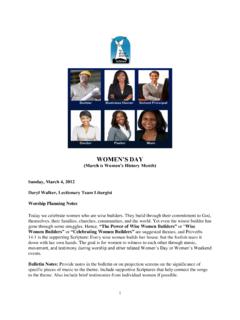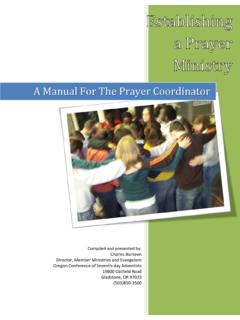Transcription of WOMEN’S DAY (March is Women’s History Month)
1 1 women S DAY ( march is women s History month ) CULTURAL RESOURCES Sunday, march 3, 2013 Guest Cultural Resource Commentator: Florence Williams, women Ministry President, educator, and community leader, Marin City (Sausalito), CA I. Introduction women s Day on African American church calendars provides churches with opportunities to expand their knowledge, address issues facing the 2 African American female, and acknowledge contributions and sacrifices countless women have made to the Black Church, families, and communities. Additionally it is a time to encourage younger women and men to catch the torch and keep on running to meets the needs of our community.
2 The biblical message of Queen Esther speaks some important truths to this generation of church women . In the book of Esther, Mordecai appeals to Esther to use her power and influence to save her people. What is the role of the black Christian woman in times like these? We too are to use our power and influence as torch bearers, just as did Esther. Black Christian women have historically shown social and spiritual sensitivity relative to the issues they faced. These women do as Paul suggested redeem the time. They are not idle, for idleness is a handmaid of Satan. Black women must continue to use their influence for the good of others, such as their family, the body of Christ, other young women , and the world.
3 Mordecai reminded Esther that God had a plan for her life. God has a plan for us too. We can use the influence we have to uplift the world and glorify God. II. History women have traditionally been the dominant demographic within the black church since its ascendance in the years following Reconstruction. The majority presence of women can be explained through a number of factors, but of most import is the fact that the church has represented the primary sphere through which women of all economic means and educational backgrounds found a way to improve their communities and redefine notions of respectability and morality.
4 Although most denominations and/or individual churches refused to acknowledge the calling of women to preach the gospel or their ability to serve in traditional leadership roles, women found alternative ways to deliver the good news and insure the financial stability of and expand the core mission of these churches. Noting the historic and monumental work of women within the Baptist denomination, in 1908 Nannie Helen Burroughs, then head of the women s Convention of the National Baptist Convention (NBC), introduced the concept of a National women s Day during the organization s annual convention.
5 The day would be the one instance in black church life where the contributions of women would be celebrated and commemorated by the black church. In her book Righteous Discontent, Evelyn Brooks Higginbotham says that the day was originally sanctioned to be celebrated on the last Sunday in July and was conceived as an expression of 3 sisterhood and a means of financial support for the women Caucus. Over the years, the celebration of women s Day spread to other denominations, religious societies, and white churches. Today, women are usually assessed a special offering, but in years past individual auxiliaries and members engaged in various fundraising activities.
6 The presentation of monies raised served as one of the highlights of the service. These offerings have insured the financial stability of many churches, supported missions to Africa and other countries, and provided financial support for pastors and delegates to denominational meetings and conventions. Many contemporary churches also have expanded the activities of women s Day beyond one Sunday service, with the addition of prayer breakfasts, spiritual retreats, workshops, and panels. For over a hundred years, women s Day has remained a central day in the celebratory life of the black church.
7 women s Day is important because it continues to give women an opportunity to plan worship and proclaim the Good News as teachers and preachers, as well as address the struggles and concerns evident in the lives of women in our church communities and in the world. In light of our ongoing efforts to encourage women and girls in the church and the world, we celebrate women s Day and praise God for women like Nannie Helen Burroughs who made a great sacrifice and took a risk at a time when women were just beginning to see a small light in the tunnel in many churches of our society.
8 God s women make a vital contribution to the kingdom of Christ on earth. Whether they are continuing steadfastly in prayer, doing good works and deeds (Acts 9:36), showing hospitality, teaching the word in harmony with divine authority, being good wives, rearing godly children, or accomplishing various other commendable tasks, let us rise up and call them blessed. Jesus chose a woman to be the person to whom he first appeared. This woman would be a prototype of the believer spreading the good news of salvation to the world. Mary Magdalene went and told the mourning and weeping male disciples that Jesus was raised indeed!
9 The male disciples were too filled with fear and unbelief; they were not ready to announce Jesus resurrection. They didn t believe Mary Magdalene when she made her announcement. But she knew she had seen the Lord. III. Historic Pentecostal women in Ministry According to Vinson Synan, The Azusa Street revival also brought women s ministries to the forefront. One of the most influential ladies at Azusa Street was Jennie Evans Moore, who married William Seymour in 1908. She served faithfully at his side during the great revival days and often filled the pulpit while her husband was away.
10 After her husband s death in 1922, she pastored the church until 1931. She died in 1936. Other African-American women who played leading roles were Lucy Farrow and Julia Hutchins. Farrow, Seymour s prayer warrior, prayed hundreds of seekers through to the tongues experience. She later led a missionary band to Liberia where she planted Pentecostal churches. Julia Hutchins, who 4 had locked Seymour out of her church, soon became a Pentecostal and helped run the Mission. Jennie Moore, Lucy Farrow, Julia Hutchins, Clara Lum, and Florence Crawford became the first of many women Pentecostal ministers who spread the message around the world.


















